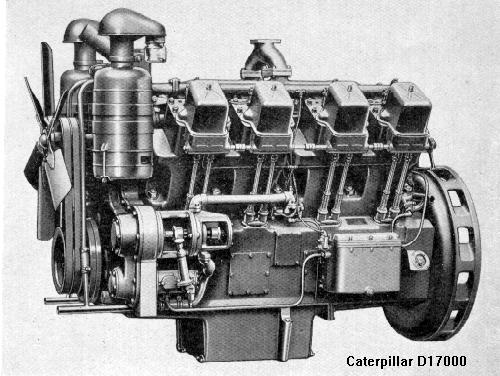Caterpiller D17000 Diesel Engine
| Bore | Stroke | Cyl. Disp | Rated RPM |
|---|---|---|---|
| 5.75" | 8" | 202 cu. in. | 1000 |

| Bore | Stroke | Cyl. Disp | Rated RPM |
|---|---|---|---|
| 5.75" | 8" | 202 cu. in. | 1000 |

Photo and text from "Diesel-Electric Locomotive", Foell and Thompson, 1946. .Main Frame and Crankcase: The crankcase is cast separate from the cylinder block. It is made of high strength alloy cast iron, with reinforcing sections and webs which give additional strength. The main bearings are held in place by a type of construction which assures permanently accurate location of the lower half of the bearing with respect to the upper half. Inspection openings are provided in the side of the case for maintenance of bearings. An oil pan of heavy construction, bolted to the crankcase, serves as a reservoir for the lubricating oil supply.
Cylinder Heads: The cylinder heads are cast individually for each cylinder. They are of nickel-chrome-iron with large water cooling areas. Valve-in-head construction is employed, thus providing easy maintenance for this important engine element. The entire valve-operating mechanism is totally enclosed. The pre-combustion chambers, one located in each cylinder, are removable.
Cylinder Liners: Cylinder liners are of the wet type, easily removed, and cast of alloy iron hardened by the "Hi-Electro" process for wear-resisting qualities. The walls are thick to avoid distortion and the inner surface is honed to a smooth finish. The liner is sealed at the top by a flange joint and copper gaskets, and at the bottom by 2 rubber sealing rings, which permit expansion and contraction of the liner during temperature changes, without leakage of cooling water.
All liners are chemically treated before installation to form a surface on the inside of the liner to assure rapid seating between the piston rings and the liner, and better lubrication during the breaking-in period.
Pistons: The pistons are of massive design and are made of aluminum alloy to provide the best heat dissipation and light reciprocating weight. Their design and construction give great piston strength and good heat control. The head is dished to provide part of the combustion space. Deep, narrow-sectioned ring grooves provide for a large ring bearing surface in the piston with minimum friction between rings and cylinder walls. There are 4 compression rings and 2 oil control rings per piston, all above the piston pin.
The piston-pins are carburized, hardened and ground to extremely low limits. They are of full-floating hollow type, free to turn in both piston and connecting rod. Snap rings hold the pin in position.
Connecting Rods: Connecting rods are of strong H-section design and are made of a special high carbon steel, drop-forged and heat-treated. The lower bearing is babbitt-lined and is of the precision type. The bearings are finished to an exact size and can be installed without shimming, filing or hand-fitting. The upper bearing is a heavy bronze precision-bored bushing which fits into the small end of the rod. A rifle-drilled passage through the rod provides for pressure lubrication to the piston-pin.
Crankshaft: The crankshaft is a high-carbon steel drop forging. Main and crankpin journals are large in diameter, "Hi-Electro" hardened and super-finished. Drilled passages are provided for pressure lubrication to the crankpin bearings and other parts.
Spiral threads are cut on the rear main journals to return the excess oil to the oil pan and prevent loss of the oil past the rear bearings. Spring-loaded leather seals ahead of the front bearings keep oil in and dirt out at this point. The journals are of the correct diameter and length to assure safe unit bearing pressures and liberal protection against failure due to torsional loads.
Main Bearings: The main bearings are steel-backed, babbitt-lined precision bearings which do not require scraping, shimming or hand-fitting of any sort. The bearing shells are held in place by heavily-trussed caps which are fitted accurately into bearing ways machined in the crankcase. The crankcase and bearing caps are precision bored to receive the shells. This type of construction assures the permanently accurate location of bearing caps in relation to bearing shells, with resulting longer life for both crankshaft and bearings. Covered openings in the crankcase permit convenient inspection of main and connecting rod bearings.
Thrust Bearings: End thrust of both the crankshaft and camshaft is taken by special bronze and cast-iron thrust bearings at the front end of the shafts. These bearings assure correct alignment of the timing gears, and relieve the main bearings of all thrust loads. A hole drilled in the crankshaft carries oil from the front main bearing to the crankshaft thrust bearing.
 Back to the Diesel Roster
Table
Back to the Diesel Roster
Table
